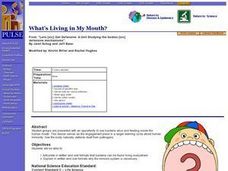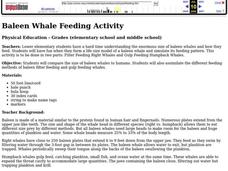Teach Engineering
Abdominal Cavity and Laparoscopic Surgery
Get to know the human body from the inside out. The first lesson plan in a series of 10 introduces the class to the abdominopelvic cavity. Biomedical engineers need to understand the region of the body as they develop and improve...
Curated OER
Human Anatomy- How Do We Move?
Learners explore the human anatomy. In this respiratory system lesson, students conduct an experiment to simulate the capacity of human lungs.
Curated OER
Hands on Your Heart - Biology Teaching Thesis
Students are able to recite the circulation of blood through the heart's various cavities and valves. They are able to appreciate what the actual valves and chambers of the heart look like. Students also have a clear vision of why the...
Baylor College
Breathing Machine
Take a deep breath and have your class construct working models of a lung! Using 500ml plastic bottles as the chest cavity, and balloons for the lung and the diaphragm, learners work in groups to make a model. The models help them to...
Curated OER
Do You Have the Guts?
Seventh graders Name and locate the major internal organs of the human body and the frog. Students virtually dissect a frog and compare organs to the human organs. Students draw illustrations of their learnings.
Curated OER
How to Make a Model of the Human Respiratory System
Students label parts of the human respiratory system on a diagram. They explain the function of diaphragm.
Curated OER
How Does Radon Affect Human Lungs?
Middle schoolers identify the different parts of the respiratory system of the human body. They work together to complete an activity and worksheet about the effects of radon on the lungs. They research lung diseases if time permits.
Curated OER
Questions regarding the Digestive System
In this science related worksheet, learners locate and answer thirty three multiple choice questions regarding the digestive system in humans.
Curated OER
Module 2: "Keeping Teeth Bright and Healthy"
Students become aware why cleaning their teeth helps keep them strong and healthy. They study basic brushing techniques, what plaque is, how a cavity is formed, why having clean teeth is an important part of having a clean body and why...
Curated OER
What's Living in My Mouth?
Students articulate in written and oral formats that bacteria can be found living everywhere. They explain in written and oral formats why the immune system is necessary. Students are presented with an opportunity to see bacteria alive...
Curated OER
Baleen Whale Feeding Activity
Students compare the size of baleen whales to humans. They also assimilate the different feeding methods of baleen filter feeding and gulp feeding whales.
Curated OER
You...Instead of the Onion Skin
Students observe their own epithelial cells from the inside linings of their cheeks using DigiScope technology. They prepare a slide with both onion cells and epithelial cells and make an illustrated booklet for a PowerPoint presentation...
Curated OER
The Language of Anatomy
Young scholars review the concept of anatomical directions. In pairs, they label each other according to those directions and label a diagram of themselves with the directions as well. They participate in a game of "Simon Says" to...
Curated OER
Broken Bones
Students listen to a lecture on broken bones. They review the proper first aid techniques and practice setting splints on one another. They observe X-rays and animal bones.
Curated OER
How Can We Make a Model of Lungs?
Fifth graders examine the function of the lungs and create a model of the lungs. Using a plastic cup, drinking straw, plastic bag, small balloon, and a rubber band, they follow step-by-step directions to construct simulated lungs. ...














